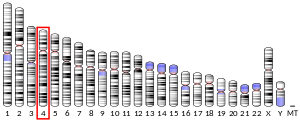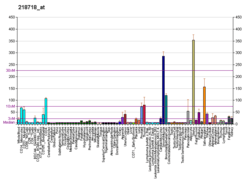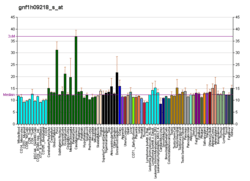PDGFC
Platelet-derived growth factor C, also known as PDGF-C, is a 345-amino acid protein that in humans is encoded by the PDGFC gene.[5][6] Platelet-derived growth factors are important in connective tissue growth, survival and function, and consist of disulphide-linked dimers involving two polypeptide chains, PDGF-A and PDGF-B. PDGF-C is a member of the PDGF/VEGF family of growth factors with a unique two-domain structure and expression pattern. PDGF-C was not previously identified with PDGF-A and PDGF-B, possibly because it may be that it is synthesized and secreted as a latent growth factor, requiring proteolytic removal of the N-terminal CUB domain for receptor binding and activation.[7]
Function
The protein encoded by this gene is a member of the platelet-derived growth factor family. The four members of this family are mitogenic factors for cells of mesenchymal origin and are characterized by a core motif of eight cysteines. This gene product appears to form only homodimers. It differs from the platelet-derived growth factor alpha and beta polypeptides in having an unusual N-terminal domain, the CUB domain.[6]
PDGF-C is a key component of the PDGFR-α signaling pathway and has a specific role in palatogenesis and the morphogenesis of the integumentary tissue. The phenotypes of compound mutants imply that PDGF-C and PDGF-A may function as principal ligands for PDGFR-α.[8]
Mouse knockout studies show that PDGF-C is required for palatogenesis. Although human studies support an etiologic role for several genes in cleft lip and palate etiology (PVRL1, IRF6, and MSX1), expression levels of the mouse homologs of these genes were unaltered in Pdgfc−/− mutant embryos that develop clefts, suggesting that their activity is not related to PDGF-C signaling in palatogenesis, so PDGF-C signaling is a new pathway in palatogenesis.[9]
Interactions
PDGFC has been shown to interact with PDGFRA.[10]
PDGF-C is a latent growth factor with proteolytic activation, and the processing enzyme might be controlled by the other CLP-associated genes that may indirectly connect to PDGF-C signaling. Notably, a 30-cM region on human chromosome 4, where the PDGFC gene maps, shows strong linkage association with CLP26, and clinical genetic data further suggest a potential link between PDGFC gene polymorphism and cleft lip and palate.[8]
References
- GRCh38: Ensembl release 89: ENSG00000145431 - Ensembl, May 2017
- GRCm38: Ensembl release 89: ENSMUSG00000028019 - Ensembl, May 2017
- "Human PubMed Reference:". National Center for Biotechnology Information, U.S. National Library of Medicine.
- "Mouse PubMed Reference:". National Center for Biotechnology Information, U.S. National Library of Medicine.
- Hamada T, Ui-Tei K, Miyata Y (June 2000). "A novel gene derived from developing spinal cords, SCDGF, is a unique member of the PDGF/VEGF family". FEBS Lett. 475 (2): 97–102. doi:10.1016/S0014-5793(00)01640-9. PMID 10858496.
- "Entrez Gene: PDGFC platelet derived growth factor C".
- Li X, Pontén A, Aase K, Karlsson L, Abramsson A, Uutela M, Bäckström G, Hellström M, Boström H, Li H, Soriano P, Betsholtz C, Heldin CH, Alitalo K, Ostman A, Eriksson U (May 2000). "PDGF-C is a new protease-activated ligand for the PDGF alpha-receptor". Nat. Cell Biol. 2 (5): 302–9. doi:10.1038/35010579. PMID 10806482.
- Ding H, Wu X, Boström H, Kim I, Wong N, Tsoi B, O'Rourke M, Koh GY, Soriano P, Betsholtz C, Hart TC, Marazita ML, Field LL, Tam PP, Nagy A (October 2004). "A specific requirement for PDGF-C in palate formation and PDGFR-alpha signaling". Nat. Genet. 36 (10): 1111–6. doi:10.1038/ng1415. PMID 15361870.
- Choi SJ, Marazita ML, Hart PS, Sulima PP, Field LL, McHenry TG, Govil M, Cooper ME, Letra A, Menezes R, Narayanan S, Mansilla MA, Granjeiro JM, Vieira AR, Lidral AC, Murray JC, Hart TC (December 2009). "The PDGF-C regulatory region SNP rs28999109 decreases promoter transcriptional activity and is associated with CL/P". European Journal of Human Genetics. 17 (11): 774–84. doi:10.1038/ejhg.2008.245. PMC 2788748. PMID 19092777.
- Gilbertson DG, Duff ME, West JW, Kelly JD, Sheppard PO, Hofstrand PD, Gao Z, Shoemaker K, Bukowski TR, Moore M, Feldhaus AL, Humes JM, Palmer TE, Hart CE (July 2001). "Platelet-derived growth factor C (PDGF-C), a novel growth factor that binds to PDGF alpha and beta receptor". J. Biol. Chem. 276 (29): 27406–14. doi:10.1074/jbc.M101056200. PMID 11297552.
Further reading
- Li X, Pontén A, Aase K, et al. (2000). "PDGF-C is a new protease-activated ligand for the PDGF alpha-receptor". Nat. Cell Biol. 2 (5): 302–9. doi:10.1038/35010579. PMID 10806482.
- Tsai YJ, Lee RK, Lin SP, Chen YH (2000). "Identification of a novel platelet-derived growth factor-like gene, fallotein, in the human reproductive tract". Biochim. Biophys. Acta. 1492 (1): 196–202. doi:10.1016/s0167-4781(00)00066-x. PMID 11004490.
- Zwerner JP, May WA (2001). "PDGF-C is an EWS/FLI induced transforming growth factor in Ewing family tumors". Oncogene. 20 (5): 626–33. doi:10.1038/sj.onc.1204133. PMC 3860748. PMID 11313995.
- Uutela M, Laurén J, Bergsten E, et al. (2001). "Chromosomal location, exon structure, and vascular expression patterns of the human PDGFC and PDGFC genes". Circulation. 103 (18): 2242–7. doi:10.1161/01.cir.103.18.2242. PMID 11342471.
- Zwerner JP, May WA (2002). "Dominant negative PDGF-C inhibits growth of Ewing family tumor cell lines". Oncogene. 21 (24): 3847–54. doi:10.1038/sj.onc.1205486. PMID 12032822.
- Andrae J, Molander C, Smits A, et al. (2002). "Platelet-derived growth factor-B and -C and active alpha-receptors in medulloblastoma cells". Biochem. Biophys. Res. Commun. 296 (3): 604–11. doi:10.1016/S0006-291X(02)00917-8. PMID 12176024.
- Strausberg RL, Feingold EA, Grouse LH, et al. (2003). "Generation and initial analysis of more than 15,000 full-length human and mouse cDNA sequences". Proc. Natl. Acad. Sci. U.S.A. 99 (26): 16899–903. doi:10.1073/pnas.242603899. PMC 139241. PMID 12477932.
- Reigstad LJ, Sande HM, Fluge Ø, et al. (2003). "Platelet-derived growth factor (PDGF)-C, a PDGF family member with a vascular endothelial growth factor-like structure". J. Biol. Chem. 278 (19): 17114–20. doi:10.1074/jbc.M301728200. PMID 12598536.
- Eitner F, Ostendorf T, Kretzler M, et al. (2003). "PDGF-C expression in the developing and normal adult human kidney and in glomerular diseases". J. Am. Soc. Nephrol. 14 (5): 1145–53. doi:10.1097/01.ASN.0000062964.75006.A8. PMID 12707385.
- Clark HF, Gurney AL, Abaya E, et al. (2003). "The Secreted Protein Discovery Initiative (SPDI), a Large-Scale Effort to Identify Novel Human Secreted and Transmembrane Proteins: A Bioinformatics Assessment". Genome Res. 13 (10): 2265–70. doi:10.1101/gr.1293003. PMC 403697. PMID 12975309.
- Fang L, Yan Y, Komuves LG, et al. (2004). "PDGF C is a selective alpha platelet-derived growth factor receptor agonist that is highly expressed in platelet alpha granules and vascular smooth muscle". Arterioscler. Thromb. Vasc. Biol. 24 (4): 787–92. doi:10.1161/01.ATV.0000120785.82268.8b. PMID 15061151.
- Jinnin M, Ihn H, Mimura Y, et al. (2005). "Regulation of fibrogenic/fibrolytic genes by platelet-derived growth factor C, a novel growth factor, in human dermal fibroblasts". J. Cell. Physiol. 202 (2): 510–7. doi:10.1002/jcp.20154. PMID 15389578.
- Campbell JS, Hughes SD, Gilbertson DG, et al. (2005). "Platelet-derived growth factor C induces liver fibrosis, steatosis, and hepatocellular carcinoma". Proc. Natl. Acad. Sci. U.S.A. 102 (9): 3389–94. doi:10.1073/pnas.0409722102. PMC 552940. PMID 15728360.
- Fredriksson L, Ehnman M, Fieber C, Eriksson U (2005). "Structural requirements for activation of latent platelet-derived growth factor CC by tissue plasminogen activator". J. Biol. Chem. 280 (29): 26856–62. doi:10.1074/jbc.M503388200. PMID 15911618.
- Reigstad LJ, Martinez A, Varhaug JE, Lillehaug JR (2006). "Nuclear localisation of endogenous SUMO-1-modified PDGF-C in human thyroid tissue and cell lines". Exp. Cell Res. 312 (6): 782–95. doi:10.1016/j.yexcr.2005.11.035. PMID 16443219.
External links
- PDGFC human gene location in the UCSC Genome Browser.
- PDGFC human gene details in the UCSC Genome Browser.





